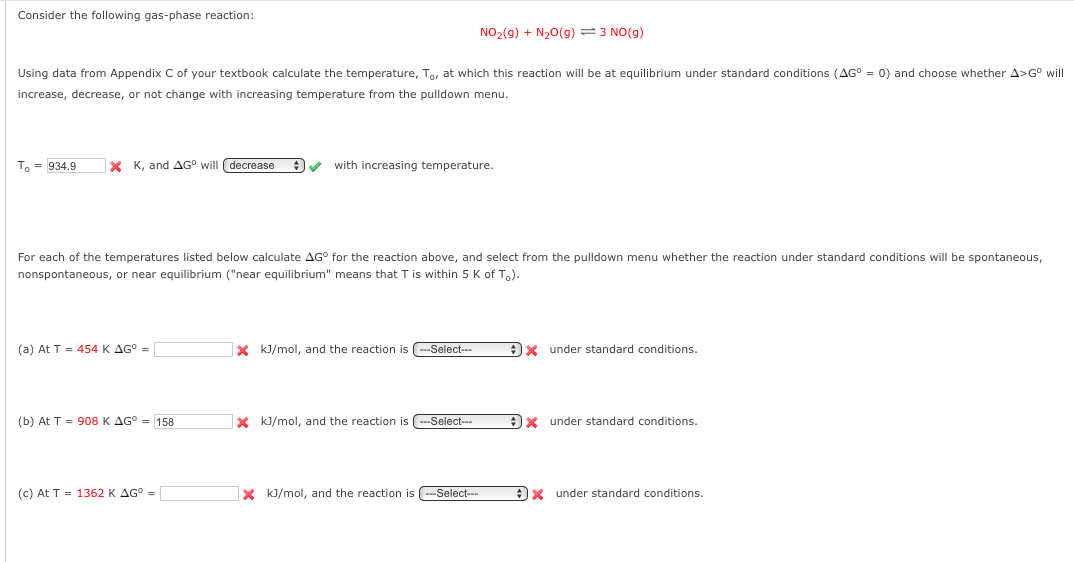Consider the following gas-phase reaction: NO2(9) + N20(g)=3 NO(g) Using data from Appendix C of your textbook calculate the temperature, To, at which this reaction will be at equilibrium under standard conditions (AG° = 0) and choose whether A>G° w increase, decrease, or not change with increasing temperature from the pulldown menu. T. = 934.9 X K, and AG° will (decrease with increasing temperature. For each of the temperatures listed below calculate AG° for the reaction above, and select from the pulldown menu whether the reaction under standard conditions will be spontaneous, nonspontaneous, or near equilibrium ("near equilibrium" means that T is within 5 K of To). (a) At T = 454 K AG° = X kJ/mol, and the reaction is --Select-- 9x under standard conditions. (b) At T = 908K AG° = 158 X k)/mol, and the reaction is -Select-- Ox under standard conditions. (c) At T = 1362 K AG° = X kJ/mol, and the reaction is -Select- 9x under standard conditions.
Consider the following gas-phase reaction: NO2(9) + N20(g)=3 NO(g) Using data from Appendix C of your textbook calculate the temperature, To, at which this reaction will be at equilibrium under standard conditions (AG° = 0) and choose whether A>G° w increase, decrease, or not change with increasing temperature from the pulldown menu. T. = 934.9 X K, and AG° will (decrease with increasing temperature. For each of the temperatures listed below calculate AG° for the reaction above, and select from the pulldown menu whether the reaction under standard conditions will be spontaneous, nonspontaneous, or near equilibrium ("near equilibrium" means that T is within 5 K of To). (a) At T = 454 K AG° = X kJ/mol, and the reaction is --Select-- 9x under standard conditions. (b) At T = 908K AG° = 158 X k)/mol, and the reaction is -Select-- Ox under standard conditions. (c) At T = 1362 K AG° = X kJ/mol, and the reaction is -Select- 9x under standard conditions.
Chemistry: The Molecular Science
5th Edition
ISBN:9781285199047
Author:John W. Moore, Conrad L. Stanitski
Publisher:John W. Moore, Conrad L. Stanitski
Chapter12: Chemical Equilibrium
Section: Chapter Questions
Problem 6QRT: Indicate whether each statement below is true or false. If a statement is false, rewrite it to...
Related questions
Question
5

Transcribed Image Text:Consider the following gas-phase reaction:
NO2(9) + N20(g) = 3 NO(g)
Using data from Appendix C of your textbook calculate the temperature, To, at which this reaction will be at equilibrium under standard conditions (AG° = 0) and choose whether A>G° will
increase, decrease, or not change with increasing temperature from the pulldown menu.
To = 934.9
X K, and AG° will (decrease
with increasing temperature.
For each of the temperatures listed below calculate AG° for the reaction above, and select from the pulldown menu whether the reaction under standard conditions will be spontaneous,
nonspontaneous, or near equilibrium ("near equilibrium" means that T is within 5 K of To).
(a) At T = 454 K AG° =
X kJ/mol, and the reaction is (--Select-
)x under standard conditions.
(b) At T = 908 K AG° = 158
X kJ/mol, and the reaction is -Select--
under standard conditions.
(c) At T = 1362 K AG° =
x kJ/mol, and the reaction is -Select-
Ox under standard conditions.
Expert Solution
This question has been solved!
Explore an expertly crafted, step-by-step solution for a thorough understanding of key concepts.
This is a popular solution!
Trending now
This is a popular solution!
Step by step
Solved in 3 steps

Knowledge Booster
Learn more about
Need a deep-dive on the concept behind this application? Look no further. Learn more about this topic, chemistry and related others by exploring similar questions and additional content below.Recommended textbooks for you

Chemistry: The Molecular Science
Chemistry
ISBN:
9781285199047
Author:
John W. Moore, Conrad L. Stanitski
Publisher:
Cengage Learning

Chemistry
Chemistry
ISBN:
9781305957404
Author:
Steven S. Zumdahl, Susan A. Zumdahl, Donald J. DeCoste
Publisher:
Cengage Learning

Chemistry: An Atoms First Approach
Chemistry
ISBN:
9781305079243
Author:
Steven S. Zumdahl, Susan A. Zumdahl
Publisher:
Cengage Learning

Chemistry: The Molecular Science
Chemistry
ISBN:
9781285199047
Author:
John W. Moore, Conrad L. Stanitski
Publisher:
Cengage Learning

Chemistry
Chemistry
ISBN:
9781305957404
Author:
Steven S. Zumdahl, Susan A. Zumdahl, Donald J. DeCoste
Publisher:
Cengage Learning

Chemistry: An Atoms First Approach
Chemistry
ISBN:
9781305079243
Author:
Steven S. Zumdahl, Susan A. Zumdahl
Publisher:
Cengage Learning


Chemistry & Chemical Reactivity
Chemistry
ISBN:
9781337399074
Author:
John C. Kotz, Paul M. Treichel, John Townsend, David Treichel
Publisher:
Cengage Learning

Principles of Modern Chemistry
Chemistry
ISBN:
9781305079113
Author:
David W. Oxtoby, H. Pat Gillis, Laurie J. Butler
Publisher:
Cengage Learning